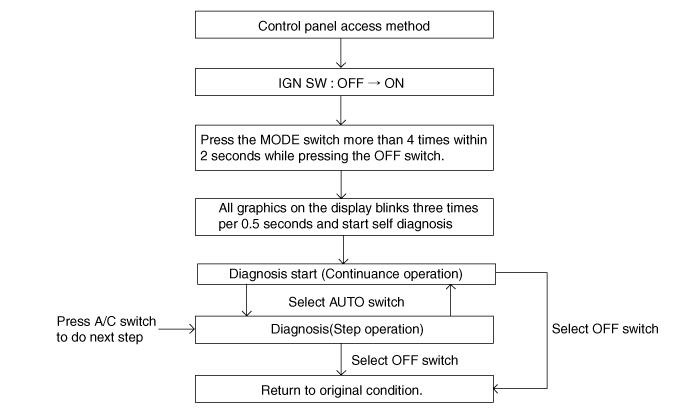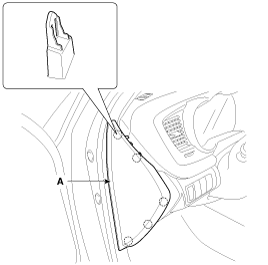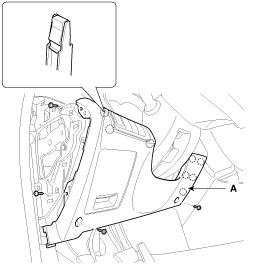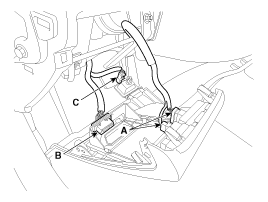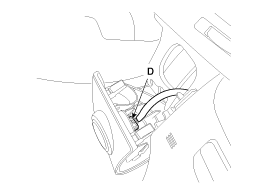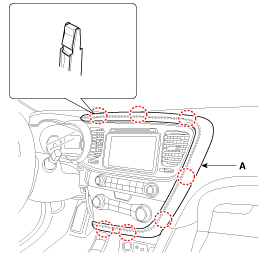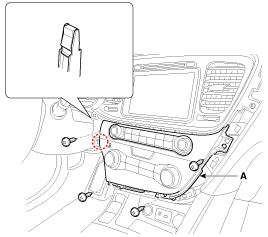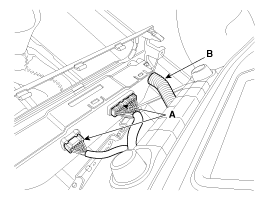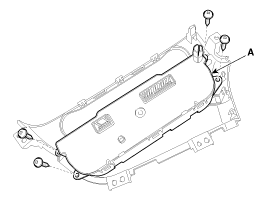Kia Optima Hybrid: Controller / Heater & A/C Control Unit(Dual) Repair procedures
| Self Diagnosis |
| 1. |
Self-diagnosis process
|
| 2. |
How to read self-diagnostic code
After the display panel flickers three times every 0.5
second, the corresponding fault code flickers on the setup temperature
display panel every 0.5 second and will show two figures. Codes are
displayed in numerical format
Fault code
|
| 3. |
Fault code display
|
| 4. |
If fault codes are displayed during the check, Inspect malfunction causes by referring to fault codes. |
| 5. |
Fail safe
|
| Replacement |
|
| 1. |
Using a screwdriver or remover, remove the crash pad side cover (A).
|
| 2. |
After loosening the mounting screws, then remove the crash pad lower panel (A).
|
| 3. |
Disconnect the crash pad lower switch connectors (A). |
| 4. |
Disconnect the diagnosis connector (B) and crash pad under lamp connector (C).
[LH]
|
| 5. |
Disconnect the start/stop button connector (D).
[RH]
|
| 6. |
Using a screwdriver or remover, remove the crash pad garnish [RH] (A).
|
| 7. |
After loosening the mounting screws, then remove the heater control unit panel (A).
|
| 8. |
Disconnect the connectors (A) and hose (B).
|
| 9. |
After loosening the mounting screws, then remove the heater control unit (A).
|
| 10. |
Installation is the reverse of removal.
|
 Heater & A/C Control Unit(Dual) Components and Components Location
Heater & A/C Control Unit(Dual) Components and Components Location
Components (1) Control Panel (Dual A/C & Heater Controller - A) Connector pin function (1) ConnectorPIN NO.FunctionConnectorPIN NO.FunctionConnector (A)1ILL+(TAIL)Connector (A)29ECV (+)2SENSOR REF ...
Other information:
Kia Optima Hybrid (TF HEV) 2016-2020 Service Manual: Description and Operation
Description Windshield deicer system prevent windshield wiper from freezing in the winter season. It consists of deicer in the lower part of windshield, switch and relay. Body control module receives an input signal from the deicer switch, then controls relay. Operating condition is the same that of ...
Kia Optima Hybrid (TF HEV) 2016-2020 Service Manual: High Voltage Shut-off Procedures
High Voltage Shut-off Procedures Be sure to read and follow the “General Safety Information and Caution” before doing any work related with the high voltage system. Failure to follow the safety instructions may result in serious electrical injuries. • High voltage components: ...

